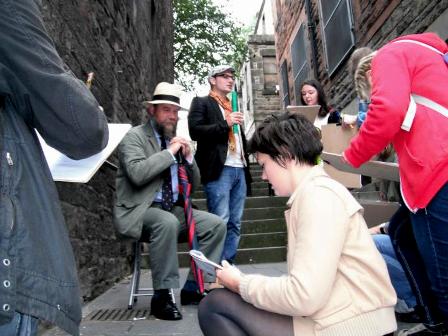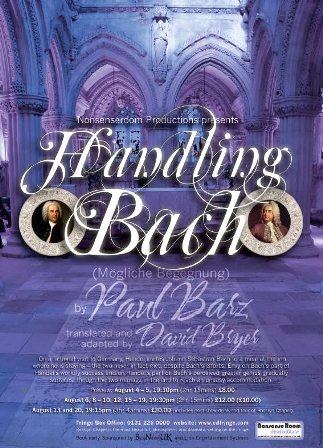
Out and about on the Fringe: drawing a crowd with Drawabout
Drawing a good crowd: the Edinburgh Fringe from every angle
In Scotland they call it ‘dreich’ (damp, overcast, chilled, a tendency to misery) and in Edinburgh this August the weather may have been just that but for Fringe veteran James Bryce there was no cause to whimper. In this appropriately eclectic article he reviews a show, plugs his own and gives the would-be Fringe performer some sound advice.

Out and about on the Fringe: drawing a crowd with Drawabout
From early morning to the early hours the High Street, the main section of the Royal Mile which flows from Edinburgh Castle to Holyrood Palace, is awash with regulars, holiday-eyed visitors, grim-faced locals and costumed performers, eagerly thrusting flyers into the hands of passers-by. To the right a fire-eater, to the left a flamenco guitarist, ahead a moving statue’ perhaps a hundred buskers in a day, switched every half-hour with military efficiency by redcoats. For the period of the Festival and Fringe this is no longer Scotland: it is the bustling Mediterranean, a mediaeval bazaar of the arts.
Around the city 21,000 performers cram into church halls, tents, pubs, plush antique rooms: 370 venues in all, housing 2,500 productions. The whole is a glorious yell of hope. It has to be; venue hire ranges from £100 an hour to £10,000 a week. Plus the digs, plus the publicity, plus the sometimes inflated cafe prices, plus, plus, plus. To see a show will knock you back around twelve quid for an hour’s performance; to perform, you might make a little something but equally you might kick yourself £20,000 into debt.
Today we are heading for the Grassmarket to experience something of the burgeoning Free Fringe (607 shows this year), a reaction to the growing commercialism of some of the bigger venues. Outside the Beehive pub we find Adam Oliver, co-founder with Cressida Brown of Drawabout, a brusque, enthusiastic man with a thread-thin beard, three helpers, and a trolley full of drawing materials. For an hour we are to draw portraits. He reassures us that we don't need to be Michaelangelos.
We join a motley bunch; a couple of students, a bemused pensioner and a rather loud lad from Glasgow who seems embarrassed by the whole thing (“AH DOAN KNOW IF AH CAN DAE THIS – AH CANNY DRAW”) but joins in nonetheless. With minimum preamble, drawing boards are distributed and Adam takes us through some two-minute exercises, one of which involves self-portraiture with eyes closed, and self-consciousness largely dissolves. Now it is time to find subjects. “Have a look round, see who interests you.” Uh-oh, we don't have to ask strangers do we? No. Adam is our conduit, putting potential sitters politely and charmingly at ease. There are a couple of panicky “Oh-my-god-they're-asking-me-for-something” refusals but on the whole everyone’s game.
There is Catherine from the Pyrenees; a pair of tango dancers; two sixteen-year-olds, all legs and lipstick; a forty-year-married couple; and more. All are drawn in under six minutes while Adam chats to them about themselves and their lives, flowing into fluent French and Spanish when required. We incorporate the information into our work. The quality is varied, of course, but that is not the point. The point is expression, joie de vivre, what the hell! Adam reacts positively to everyone's work and at the end of each session, the ‘sitters’ are given the drawing of their choice. Hour over, Adam takes us through a couple of ‘hello’ exercises which many of us would have run a mile from an hour ago and we separate, refreshed, hard-worked but bonded, renewed, and wondrous at the diversity of the world and the joy of a simple “hello”. And all for a donation. If they’re ever near you (they are visiting London soon) go.
Naturally, the Fringe can be hit or miss. But how do you tell? Even when noting all the rave reviews it can be like entering a supermarket which sells nothing but baked beans. The answer is that often you can go on reviews, sometimes you cannot. One five-star performance I witnessed made me wish I had spent the money on Prozac. After a performance of Miss Julie, I resolved never to watch a Strindberg again (more a reflection on the playwright than the actors, two out of threeof whom were fine). A Japanese solo musical featuring Toulouse-Lautrec. A hilarious and instructive literary pub tour, which is what it says on the can. I was recommended to see Adolf Hitler singing Frank Sinatra but could not fit it in.
They are all there: the famous (John Malkovitch was seen handing out flyers for a show he directed), the obscure and the near-invisible. On the official Festival I was pleased to catch Ravi Shankar, now 91, while six miles out of town, the Rosslyn Chapel (now of DaVinci Code fame) was showing Handling Bach, a four-star production by Nonsenseroom about a meeting between composers Handel and Bach. A great production, eulogised by the audiences (which would have been bigger if the Fringe brochure had not missed out a couple of dates) and I can say that most objectively, because I was playing Handel (with Simon Tait as Bach and Andrew Dallmeyer as Schmidt).
If you think being a consumer of the Fringe is fraught you should try being a provider. Or perhaps not? In case, for some reason, you are tempted, let an old campaigner offer some advice.
For more details of Drawabout visit www.drawabout.org
The Leisure Review, September 2011
© Copyright of all material on this site is retained by The Leisure Review or the individual contributors where stated. Contact The Leisure Review for details.
Download a pdf version of this article for printing

Without doubt The Leisure Review's favourite Festival event